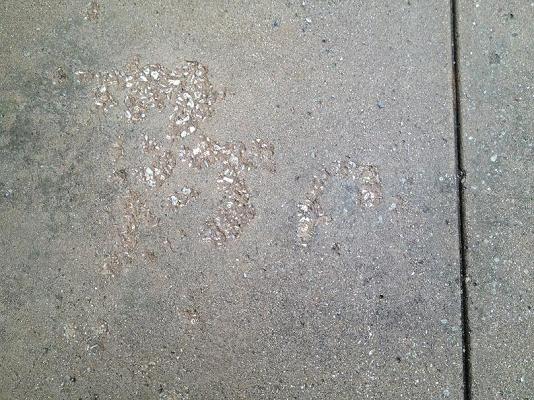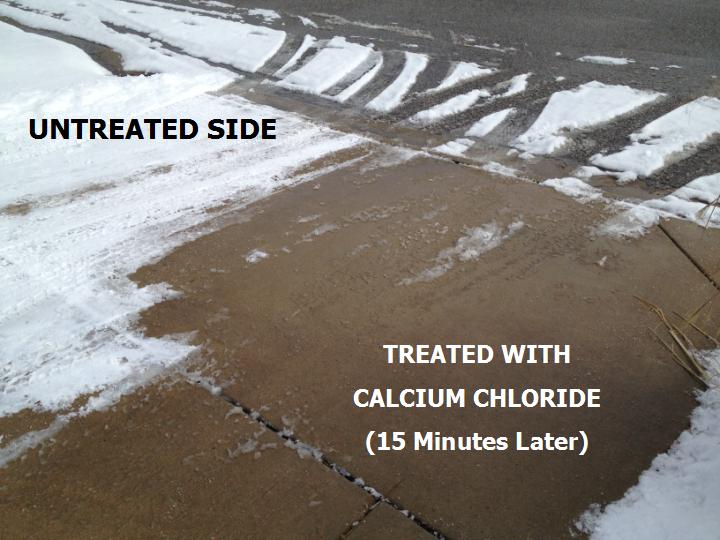Concrete Damage From Rock Salt
It is common knowledge that rock salt will damage concrete sidewalks and driveways. However, what is not well known is that ALL ice-melters can damage conrete. This article will explain how and why it happens, and what can be done to help prevent this damage.
The Freeze/Thaw Cycle
Everyone knows that water freezes at 32 degrees and forms ice or snow. How ice melters work is to lower the freezing point of water below 32 degrees. Rock salt will lower the freezing point from 32 degrees to 25 degrees, and Calcium chloride will lower the freezing point to –25 degrees.
Why this matters is that rock salt will change (melt) ice and snow back into water when the temperatures are between 32 and 25 degrees. However, when the temperature continues to fall and gets below 25 degrees the water re-freezes. Then when temperatures rise again to above 25 degrees, the rock salt residue changes the ice back into water. This is called the freeze/thaw cycle.
Why Damage Is Caused?
Although concrete sidewalks and driveways look very solid, concrete is actually a porous material that can and does absorb water. In cold weather the snow or ice is a solid and does not penetrate into concrete. But, when ice melters are applied to snow or ice, the melting ice/snow is turned into a salt/water mix and is absorbed by concrete.
Additionally, rock salt is hydroscopic, which means that rock salt actually attracts more water to it. So when ice is melted by rock salt and changes into a salt/water mix, it enters the concrete with approximately 10% more water than would normally enter concrete. When temperatures fall below 25 degrees, having this extra water in concrete causes a large problem. In these colder temperatures, the extra water in the salt/water mix starts to re-freeze and expand, but the additional water adds additional ice in the concrete, which in turn adds additional hydraulic pressure on the concrete.
When the hydraulic pressures of the re-freezing water exceeds the compression strength of the concrete, damage can occure. Additionally, the more often the freeze/thaw cycle happens, the more likely the damage is to occur. This being said, a one-time use of rock salt is unlikely to cause damage.
What Damage Looks Like:
The freezing water inside the concrete creates so much upward pressure on the concrete, that the smooth, non-aggregate top of concrete can “pit” or spall. This damage can be in large sections or in scattered smaller spots. When the smooth finished texture of the concrete is gone, these damaged spots show the aggregate mixture of the concrete that is below.
All Concrete Is Not The Same
All concrete is not created equal. The types of concrete that are most susceptible to spalling damage is freshly poured concrete and low strength concrete. Newly poured concrete, which is still holding a high water content already, usually needs around 30 days to “harden off” before rock salts can be used.
Low strength concrete mixtures can also be at greater risk from spalling. Concrete mixes with a compressive strength of less than 3,500 pounds per square inch could also show more spalling damage than other concretes. Low strength concretes also have a higher porosity, allowing more of the damaging salt/water mix to enter the concrete.
What Ice Melter Should Be Used On Concrete?
The preferred ice melter for concrete surfaces in the Midwest is Calcium Chloride. Calcium Chloride pellets are a fast acting product that melts ice/snow, and resists re-freezing to a temperature of –25 degrees. This protection to lower temperatures reduces the frequency and damage potential of the freeze/thaw cycles.
Are Concrete “Brick” Pavers Affected?
No. To be considered a concrete or “brick” paver, the concrete used in the mix must have a compression strength of over 8,000 pounds per square inch. This high quality concrete therefore has a very low porosity and allows very little water into the concrete. This is another reason why concrete pavers are a better choice than concrete for sidewalks and driveways.
Other Types Of Ice Melters
In our area, there are four main types of ice melters that are commercially available. They are as follows:
Rock Salt (25 Degrees Protection)
Potasium Chloride (15 Degrees Protection)
Magnesium Chloride (-13 Degrees Protection)
Calcium Chloride (-25 Degrees Protection)
Many suppliers are now offering custom blends of these chemicals to reduce cost, however, these custom blends are less effective than the straight products.
What NOT To Use
The most damaging of all ice melters contain ammonium nitrate and/or ammonium sulfate. These chemicals attack concrete chemically and can cause great damage, therefore should never be used as ice melters. Please note that these chemicals are locally available and are actually still used by some landscape companies.



